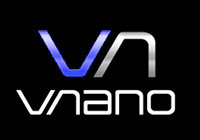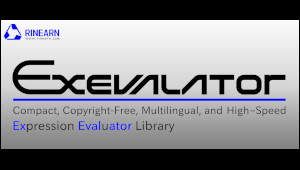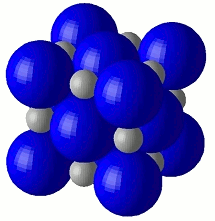VCSSL (Programming Language)
» More Details
Features
VCSSL features a simple C-like syntax, making it easy for those already familiar with other C-like languages (C, C++, C#, Java, etc.) to quickly become proficient in VCSSL.
Additionally, the entire VCSSL runtime environment, including the scripting and graphics engines, is implemented in Java. This ensures that VCSSL is compatible with various PC operating systems, such as Microsoft® Windows®, Linux, and others.
| More Details | Download |
Vnano (Scripting Engine)
» Details
Features
Vnano allows Java applications to interpret scripts and calculation expressions provided as string values.
As a scripting language, Vnano is derived from VCSSL and features a simple C-like syntax, making it immediately accessible to those familiar with C-like languages.
Vnano achieves high-speed script processing by executing intermediate code on a virtual machine (VM) designed as a vector register machine. It delivers peak performance of approximately hundreds of MFLOPS (64-bit) for scalar operations and several GFLOPS (64-bit) for vector operations.
Exevalator (Expression Calculator Library)
» More Details
Features
Exevalator is a compact library that allows you to evaluate numerical expressions stored as strings in Java, C#, C++, Rust, Visual Basic, and TypeScript programs. Each language implementation is provided in a single source file, making it easy to integrate into your applications.
Additionally, Exevalator is distributed under the Unlicense or CC0, which are terms nearly equivalent to being in the public domain.
Vector Register Intermediate Language (VRIL)
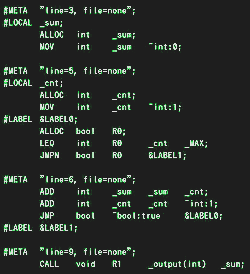
Features
VRIL stands for "Vector Register Intermediate Language," and as its name suggests, it is designed based on a register machine VM implementation equipped with vector unit virtual registers/memory.
Since VRILfs instruction set is almost entirely composed of virtual SIMD instructions, the proportion of actual computation time to instruction execution overhead is high in vector operations, resulting in excellent performance. Additionally, as it uses a simple three-address code format, it is easy to optimize, allowing for high scalar computation performance as well.
In the future, VRIL will be adopted in the VCSSL language processing system. Currently, it is being implemented first in its subset, Vnano.
Vector Register Virtual Machine (VRIL-VM)
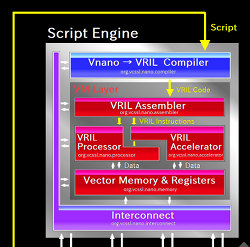
Features
Designed with both scalar and vector computation performance in mind, it is built using a register machine architecture with vector processor-like instructions, making it suitable for use in data analysis software. Specifically, VRIL, an intermediate code language centered around SIMD instructions, is adopted, and all data units in the registers and memory are vectors (arrays).
In terms of real-world performance, even though the entire intermediate code interpreter is implemented in Java, it delivers peak performance of several hundred MFLOPS (scalar computation) to several GFLOPS (vector computation) in double-precision floating-point arithmetic. This strikes a high balance between platform independence, ease of embedding into applications, and numerical computation performance.
VRIL-VM is planned to be adopted in the VCSSL language processing system in the future, and currently it is being implemented first in its subset, Vnano.
VRIL Code Compiler LexicalCraft

Features
LexicalCraft is primarily designed for embedding in applications. Structurally, it follows a common four-stage process (lexical analysis, syntax analysis, semantic analysis, and code generation) while keeping the optimization handled by the VM. To ensure customizability, it emphasizes the separation of each stage and aims to minimize complexity and implementation size.
Additionally, since it is intended for use in applications, the compiler is designed with non-recursive implementations for all stages, including the parser, to minimize the likelihood of issues such as stack overflow during compilation.
LexicalCraft is currently being developed and implemented as part of the intermediate code compiler layer in the Vnano scripting engine.
AST Interpreter: GARNET
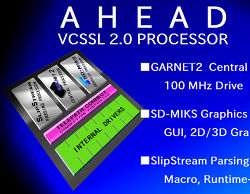
Features
Its architecture is broadly classified as an AST (Abstract Syntax Tree) interpreter. It executes code relatively efficiently by linking a collection of polymorphically specialized operation objects into a tree structure that is isomorphic to the abstract syntax tree.
GARNET has been used as the execution layer of the VCSSL processing system since its earliest versions. However, as its performance improvements have plateaued and the implementation has become increasingly complex, it is planned to be replaced by the VRIL-VM in future versions of VCSSL.
After that, GARNET will serve as a compatibility engine. Therefore, instead of further expansions, current development efforts are focused on fixes and maintenance to ensure stability.
Simple 3D Rendering Library RINEARN-X
Features
This library is intended for simple 3D rendering, such as data visualization, without requiring the mathematical descriptions typically needed for 3D, such as vectors and transformation matrices. It originated as a derivative of the rendering engine in RINEARN Graph 3D and is currently used in the 3D rendering features of VCSSL's lower layers.
Others
Advanced Development Version (Pre-release Versions)
For each software, we may publicly release pre-release versions, which include upcoming versions still in development or versions with experimental features implemented. For more details, please refer to the linked page.
Source Code (GitHub)
For software developed as open-source, the source code repositories are available on GitHub.
* C# and Visual Basic are registered trademarks of Microsoft Corporation in the U.S. and other countries.
* Rust is a registered trademark of the Mozilla Foundation in the U.S. and other countries.
* Other names may be either a registered trademarks or trademarks of their respective owners.













